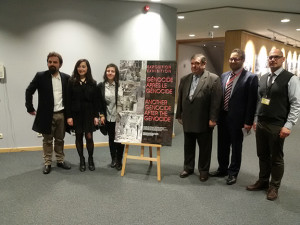‘Genocide after the Genocide’ Exhibition Opens in European Parliament
March 10, 2016
BRUSSELS, Belgium—On March 1, the exhibition “Genocide After the Genocide” officially opened in the European Parliament in Brussels, in the presence of more than 100 guests. Among those present were members of the European Parliament (EP), staff members, assistants, and representatives of the Armenian community of Belgium. The exhibition was hosted by member of the European Parliament (MEP) Nikolaos Androulakis (S&D, Greece) and co-organized by the Research on Armenian Architecture (RAA) and the European Armenian Federation for Justice and Democracy (EAFJD). This is the first time the exhibition has been held outside of the Republic of Armenia.
“Genocide after the Genocide” consists of 32 photos of Armenian churches and religious monuments before and after the Armenian Genocide. The photos depict the systematic destruction of Armenian monuments, culture, and heritage in Western Armenia—what is now Eastern Turkey. Turkey to this day denies the reality of the genocide, despite international condemnation and resolutions.
Heghine Evinyan, EU affairs officer of the EAFJD, in her opening remarks said, “An honest and open process of dealing with its past is crucial for any democratic, healthy, and forward-looking society. In fact, this is the only way to go. Therefore the Turkish society needs the recognition of the Armenian Genocide at least as much as the Armenian society needs it.”
Evinyan highlighted the fact that some Turkish intellectuals both acknowledge and openly speak about the genocide; historian Taner Akçam and Nobel Prize-winning writer Orhan Pamuk were among those she noted. “The exhibition ‘Genocide after the Genocide’ is another step towards raising awareness about the state of material testimonies of Armenian civilization in today’s Turkey,” she added.
Androulakis, in his remarks, noted that he had attended the events organized in Yerevan for the Centennial of the Armenian Genocide. “At the exhibition you can see photos of religious and other buildings of Armenian culture as they were before the genocide and in their current situation. As these photos show, the millions of dead and deported Armenians and those forced into exile were not the only victims: The purpose of the genocide was the physical and cultural extinction of Armenia,” he said. “Turkey must face historic truth and recognize the atrocities that took place at the beginning of the last century. It is our duty to preserve the memory. It is essential if we want to have a better future and avoid repeating the mistakes of the past.”
Eleni Theocharous, MEP from Cyprus and president of the EU-Armenia Friendship Group in the European Parliament, described her long-term struggle for the rights of the Armenian people, and drew a parallel between the destruction of the Armenian monuments and that of Greek heritage in Turkish-occupied North Cyprus.
Arman Israelian, counselor in the Mission of the Republic of Armenia to the European Union, said, “Today’s exhibition is an essential endeavor to draw attention to the issue of Armenian religious heritage in Turkey, and it supplements the efforts of the European Parliament in this regard. These silent witnesses of Armenian nation for so many centuries have immense cultural, religious, and historical value not only for us, Armenians, and the Christian world, but also for the entire humanity.”
On behalf of the co-organizer of the exhibition, Research on Armenian Architecture, Movses Hrair Der Kevorkian, during his remarks, said that “Genocide after Genocide” summarizes decades of research and hundreds of expeditions, during which the RAA foundation has witnessed the extinction of an entire heritage. He brought attention to the fact that while Turkey was carrying out the deliberate annihilation of Armenian heritage, it was signing several international treaties regarding the preservation of cultural monuments during times of war, including clear provisions for the care and preservation of cultural monuments pertaining to minorities and recognizing minority cultural rights. He also emphasized that the Armenian Genocide did not end when the killings stopped; this exhibition is proof of that statement, he said.
“Genocide after the Genocide” was prepared within the grant program of the Youth Foundation of Armenia, a partner organization of the President of the Republic of Armenia, as well as the “Duty of Soul” NGO.
The exhibition in the European Parliament ran through March 4. Later in the year, it will be held in various European countries.
To watch a video of the official opening, visit https://www.youtube.com/watch?v=IBcqDKdfjCA&feature=youtu.be.
Source: Armenian Weekly
Link: ‘Genocide after the Genocide’ Exhibition Opens in European Parliament
